
Lantana is a genus of about 150 species of perennial flowering plants in the verbena family, Verbenaceae. They are native to tropical regions of the Americas and Africa but exist as an introduced species in numerous areas, especially in the Australian-Pacific region, South and Northeastern part of India. The genus includes both herbaceous plants and shrubs growing to 0.5–2 m (1.6–6.6 ft) tall. Their common names are shrub verbenas or lantanas. The generic name originated in Late Latin, where it refers to the unrelated Viburnum lantana.
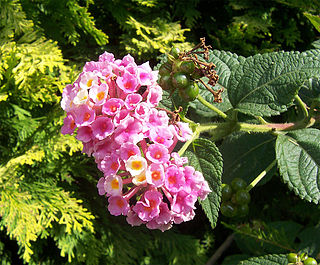
The Verbenaceae, the verbena family or vervain family, is a family of mainly tropical flowering plants. It contains trees, shrubs, and herbs notable for heads, spikes, or clusters of small flowers, many of which have an aromatic smell.

Lintneria merops is a moth of the family Sphingidae.

Lintneria praelongus is a moth of the family Sphingidae.
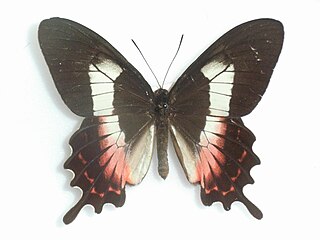
Parides ascanius, the Fluminense swallowtail, is a species of butterfly in the family Papilionidae. It is endemic to Brazil where it is confined to the municipalities of Atafona and Itaguaí.

Lantana camara is a species of flowering plant within the verbena family (Verbenaceae), native to the American tropics. It is a very adaptable species, which can inhabit a wide variety of ecosystems; once it has been introduced into a habitat it spreads rapidly; between 45ºN and 45ºS and more than 1,400 metres in altitude.
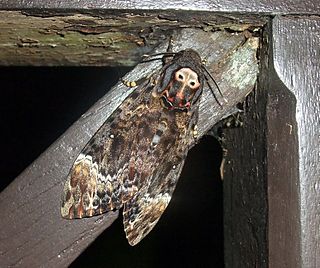
Acherontia lachesis, the greater death's head hawkmoth or bee robber, is a large sphingid moth found in India, Sri Lanka and much of the Oriental region. It is one of the three species of death's-head hawkmoth genus, Acherontia. The species was first described by Johan Christian Fabricius in 1798. It is nocturnal and very fond of honey; they can mimic the scent of honey bees so that they can enter a hive unharmed to get honey. Their tongue, which is stout and very strong, enables them to pierce the wax cells and suck the honey out. This species occurs throughout almost the entire Oriental region, from India, Pakistan and Nepal to the Philippines, and from southern Japan and the southern Russian Far East to Indonesia, where it attacks colonies of several different honey bee species. It has recently become established on the Hawaiian Islands.

Lantana montevidensis is a species of lantana known by many common names, such as: trailing lantana, weeping lantana, creeping lantana, small lantana, purple lantana or trailing shrubverbena.

Udea rubigalis, the celery leaftier or greenhouse leaftier, is a member of the family Crambidae. It is found across the Americas. The species was first described by Achille Guenée in 1854.

Lantanophaga pusillidactyla, the lantana plume moth, is a moth of the family Pterophoridae. It is native to the southern United States, Mexico, the Caribbean, and South America. It was introduced to Australia accidentally in 1936 and is now found from Sydney to Cairns along the coast. It has also been introduced to Hawaii in 1902, Pohnpei in 1948, and Palau in 1960 for biological control. It has since been recorded from Yap in 1987–1988 and is now distributed on all islands of the Mariana and Caroline Islands where the host plant is found, except Aguijan.
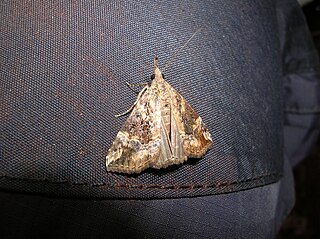
Hypena laceratalis, the lantana defoliator, is a moth of the family Erebidae. It was first described by Francis Walker in 1859. It is native to Africa to Yemen and India, but was deliberately introduced to Australia via Hawaii in 1965 to control the weed Lantana camara.
Diastema tigris, the lantana moth or lantana control moth, is a moth of the family Noctuidae. The species was first described by Achille Guenée in 1852. It is endemic to the US states of Florida and Texas, but has been introduced in Zambia, Australia, Micronesia, Fiji, Hawaii, Ghana, St. Helena, Tanzania, Uganda and Mauritius. as biological control of Lantana camara.

Verbascoside is a caffeoyl phenylethanoid glycoside in which the phenylpropanoid caffeic acid and the phenylethanoid hydroxytyrosol form an ester and an ether bond respectively, to the rhamnose part of a disaccharide, namely β-(3′,4′-dihydroxyphenyl)ethyl-O-α-L-rhamnopyranosyl(1→3)-β-D-(4-O-caffeoyl)-glucopyranoside.
Lintneria arthuri is a moth of the family Sphingidae. It is known from Bolivia.
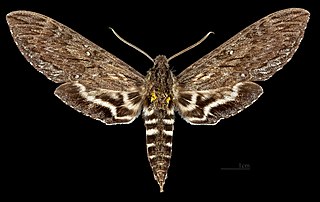
Lintneria aurigutta is a moth of the family Sphingidae. It is known from Peru, Bolivia and Argentina.
Lintneria tricolor is a moth of the family Sphingidae. It is known from Dominica.
Lintneria xantus is a moth of the family Sphingidae. It is known from Baja California and north-western Mexico.

Parevander xanthomelas is a species of beetle in the family Cerambycidae. It was described by Félix Édouard Guérin-Méneville in 1844, and has been classified in the genus Parevander since the circumscription of that genus by Per Olof Christopher Aurivillius in 1912.
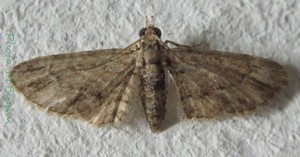
Chloroclystis costicavata is a species of moth in the family Geometridae. It is found on Mauritius and Réunion.

Aconophora compressa is a species of insect in the treehopper family, Membracidae. It is known by the common names lantana bug, lantana treehopper, lantana stemsucking treehopper, and lantana sap-sucking bug.
















